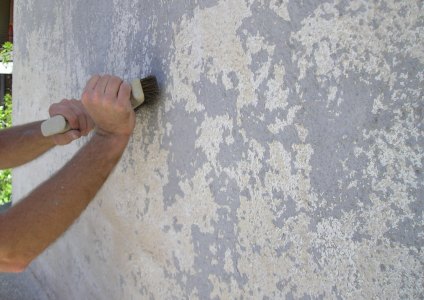Exterior walls come in many different materials. Preparing and priming each exterior surface correctly will achieve long-term protection for your home and drastically increase the service life of any paint job.
Stucco Surfaces
On stucco areas you want to thoroughly scrape off any loose paint and repair all cracks and holes. To fill gaps around windows and door casings use a caulk or elastomer-based patch to fill the cracks. (Elastomer is a polymer with property of high elasticity. The term comes from elastic polymer.)
If you are working with previously painted exterior stucco you want to use a good exterior primer or surface conditioner.
A reaction may occur if the new stucco is not allowed to properly cure. Make sure the curing time is past before applying primer. 30 days is a standard cure time for new stucco before it can be primed and painted.
Wood Siding and Trim
When it comes to priming wood surfaces, you want to scrape off all of the loose and cracking paint. After scraping off the loose paint, sand the exterior area to remove any additional loose paint and create a smoother surface.
If scraping and sanding do not work and more than 25% of the coating is cracked and peeling, you may want to consider stripping.
When you strip, you’ll use chemicals or heat to remove all of the existing coatings down to the substrate. The stripping process can be a very laborious process so you may want to weigh the pros and cons of costs vs. benefits.
An alternative to stripping is to use a penetrating sealer like Peel Stop by Zinsser to glue down the edges of the loose paint then prime that with a thick high building bonder/sealer to fill and bridge the cracks and rough surfaces. XIM Peel Bond is a good bonder/sealer that will help make rough surfaces look better.
Metal Surfaces
When you are painting iron or steel, the most important thing is good contact between the surface and the coating. Metals rust when air and moisture get under the protective coating.
Rust can be like a cancer. Once rust is in the metal, it is almost impossible to get rid of. Surface preparation is so important on iron or steel. You want to use a good rust inhibitive primer. Rusting metal must be sanded to remove loose rust, and then cleaned. Using a phosphoric acid rust conversion product can ensure that all remaining traces of oxidized iron have been eliminated. Sand to smooth out any roughness. Then clean with TSP to remove the phosphoric acid that didn’t react to rust. Dry thoroughly. Then prime with a rust inhibitive primer.
Galvanized metal comes from the factory with a residue still on the metal that prevents good paint adhesion. The best way to paint the exterior that has galvanized metal is to let the galvanized metal surface weather for about six months. Weatherizing neutralizes the surface, making it better able to hold the paint. If you must paint the galvanized metal right away, etch the surface with a mild acid such as vinegar. Rinse the surface, and then apply a coat of galvanized metal primer.
Masonite Siding
Most Masonite siding is delivered with its face primed with some sort of paint. However, if the paint has peeled or the Masonite has swelled due to water then special preparation is needed.
Pay special attention to the edges of this siding as this is its most vulnerable spot. Remove loose paint on embossed Masonite siding by carefully scraping or using a wire brush. The overlapping edge can be hand sanded with a medium/course sanding sponge. Smooth siding can be carefully sanded with a palm sander or rotating paint sander. The face of embossed, wood grained, siding cannot be sanded.
Using oil base primers seem to work the best. Apply two coats of primer to avoid any future problems. Apply primer to the overlapping edge to provide an additional seal to this vulnerable area. Primers can be sprayed on then back-rolled or back-brushed to fully seal all raw surfaces. Very Important; Priming Masonite preserves it!
Cement Board
Cement boards, also known as Hardie boards, are a type of fiber cement siding. Cement board is highly durable, resistant to fire, mold and mildew, and it does not rot.
Cement board does not need to be primed unless it will be exposed routinely to harsh weather conditions. If you do choose to prime your cement board, use an exterior acrylic latex bonding primer. Also, do not paint a cement board unless it has been thoroughly cleaned first, or you will have problems with adhesion.
ATTN: Before preparing and priming any substrate on older homes, before 1978, check for existence of lead. Homes with lead based primers and/or paints must follow the EPA RRP rules for containment and removal. Visit Lead Based Paint for more information.


